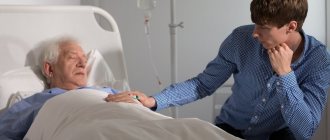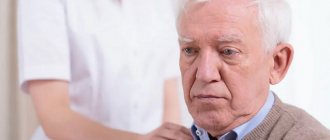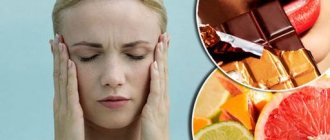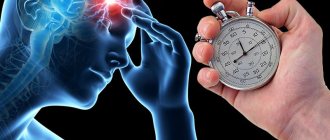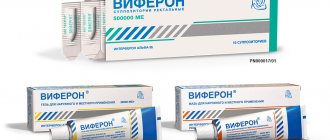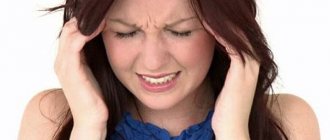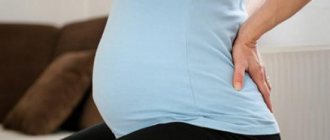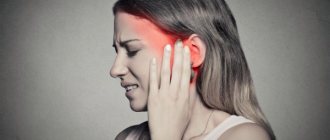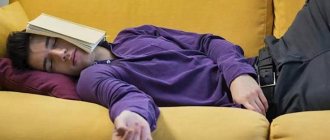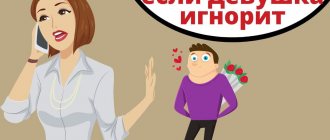August 23, 2021
A stroke is a disease in which cerebral circulation is disrupted due to a disruption in the blood supply to the brain (or spinal) cord or a rupture of a vessel. Due to an “accident”, areas of tissue in the brain are damaged or killed. This disrupts the functioning of the human body - leads to impairment of motor and cognitive functions.
There are also unique symptoms that depend on the location of the lesion in the brain. If we dive into this in detail, then, for example, with a stroke in the region of the caudate nucleus, in addition to general symptoms, a person will clearly notice mental and emotional inertia, a decrease or absence of motor activity in conversation and normal daily activities. And with a stroke in the temporoparietal region, the patient will experience psychosis and, possibly, epileptic seizures.
But these details are seen and diagnosed by specialists; for an ordinary person who has experienced a stroke, it is enough to understand the difference between a stroke of the right hemisphere and the left, and what kind of rehabilitation is needed for each of them. We will talk about this in this article.
Etiopathogenesis
The main mechanism for the development of paralysis is stroke - damage to the artery with blood escaping beyond the vascular bed. As a result, a hematoma is formed, which gradually grows and compresses the brain tissue. Vital neurons die, loss of function is noted, control of skeletal and smooth muscles decreases, and sensitivity disappears.
This condition is predisposed to:
- Eating disorders – the main role is played by a lack of calcium in the diet, which strengthens the walls of the arteries. In these cases, cardiologists repeat “where it’s thin, that’s where it breaks.” Weakened brain vessels that are prone to damage can cause a stroke;
- Hypertension – the situation is aggravated by increased blood pressure, which can damage weakened blood vessels. In older people, there is a lack of calcium, which can cause artery rupture;
- Compounded heredity - according to recent studies, there is a predisposition to vascular diseases, especially hypertension and strokes. The mechanism has not been fully studied; insufficiency of the neurohumoral mechanism and weakness of the vascular wall are assumed;
- Obesity - this condition is accompanied by a lack of minerals, an increase in blood pressure, which increases the likelihood of developing a stroke with subsequent paralysis;
- Cardiovascular diseases - valve malformations, heart failure, atherosclerosis and thrombosis predispose to cerebral hemorrhage;
- Endocrine diseases - diabetes comes first, leading to hypertension and hemorrhages. Sometimes the causes are hypothyroidism, pathologies of the adrenal cortex;
- Bad habits - nicotine weakens the walls of arteries and increases cholesterol levels in the blood. Natural alcohol in minimal dosages is useful, but an excess of surrogate or drunkenness often ends in stroke and paralysis.
The listed factors can provoke both left and right paralysis. According to statistics, the latter option is observed more often, which increases the patient’s chances of survival due to timely diagnosis.
First aid
This involves hospitalizing the victim as quickly as possible. To do this, when identifying signs of a stroke, you must first report the incident to the emergency medical service and call a specialized team. It is necessary to provide the patient with rest, a supine position and an influx of fresh air. At home, it is unlikely that anything can be done to prevent the progression of a stroke. Only early initiation of drug therapy or surgery can prevent serious health consequences from a stroke.
Clinical Brain Institute Rating: 3/5 — 11 votes
Share article on social networks
Types of paralysis
After a stroke, the doctor’s main task is to determine the presence of paralysis and its type. All hemorrhages on the right and left sides are divided into two categories:
- Peripheral paralysis is the most favorable variant of the disease, characterized by partial loss of function. The patient's motor neurons are damaged, which leads to loss of sensitivity and a decrease in complex and purposeful movements.
- Central paralysis - indicates hemorrhage in the motor areas, as a result of which the right arm and leg are completely amputated. Such patients are unable to care for themselves and there is a high risk of disability.
Diagnosis of ischemic stroke
If an ischemic stroke is suspected at the Yusupov Hospital, the patient undergoes laboratory tests and is examined using instrumental methods using modern equipment from leading companies in Europe, the USA and Japan. The results of the examination allow us to make an accurate diagnosis and prescribe adequate therapy. In order to determine the type of stroke and determine whether the left or right side of the brain is affected, computed tomography or magnetic resonance imaging is performed. Immediately after neuroimaging of a stroke, the following studies are performed:
- electrocardiography;
- ultrasonography;
- blood tests.
The patient is then examined by an ophthalmologist and an endocrinologist. Later, additional diagnostic procedures are performed:
- X-ray of the skull;
- chest x-ray;
- electroencephalogram;
- echocardiography.
After an accurate diagnosis is made, treatment for ischemic stroke is prescribed.
Signs of right-sided paralysis
If there was a stroke in the left hemisphere, the patient’s right side of the body is affected, the muscles of the limbs are paralyzed and there is no speech. These are the main differences between this condition. Patients also develop the following symptoms:
- Common symptoms are headache, nausea, vomiting and weakness. They appear in the first few days and are considered the body’s response to damage to brain neurons;
- Loss of movement - with central paralysis, the right limbs are flaccid, there is no sensitivity, the patient cannot perform any actions with the right arm and leg. If peripheral neurons are affected, the patient experiences tremor, and some movements are difficult on the same side;
- Reduced memory – there are difficulties in remembering sentences; in severe cases, it is difficult for a person to repeat individual words;
- Paresis of the right facial nerve - this branch innervates all facial muscles on its side. In the absence of control, the muscles relax, the patient’s corner of the mouth and lower eyelid “hang”;
- Spontaneous contractions of some skeletal muscles on the right - usually the arm is bent at the elbow joint, the leg is straightened, and inward rotation of the foot is noted.
The listed symptoms are observed a few minutes after hemorrhage. As health deteriorates, the patient develops stress, accompanied by depression and difficulties in communication.
Symptoms of ischemic stroke of the left hemisphere
With a left-sided stroke, paralysis of the right side of the body develops, resulting in loss of sensation and muscle dysfunction. Poor circulation in the left hemisphere of the brain leads to the following disorders:
- change in speech;
- disturbance of mental activity;
- memory loss;
- misunderstanding the meaning of words.
Patients with left hemisphere ischemic stroke often become withdrawn and develop depression. The attentive attitude of the staff of the Yusupov Hospital allows them to improve their psycho-emotional state. In 30% of patients with left-sided ischemic stroke, paresis of the right half of the body is combined with disturbances in muscle-joint sensation, which has a significant impact on the restoration of range of motion in the limbs and significantly complicates the restoration of walking and self-care. With left-sided stroke, a number of patients develop impairments in sensitivity and the ability to perform purposeful movements while maintaining strength in the limbs and full range of motion.
Along with decreased sensitivity, patients with a left-sided stroke may develop specific sensations on the right side of the body:
- tingling or crawling sensation;
- inadequate perception of irritations: the patient perceives touch as pain, and a hot object as cold;
- pain (thalamic syndrome).
After an ischemic stroke, consequences in the form of impaired coordination of movements and speech dysfunction can manifest themselves throughout life.
Expert opinion
Author: Tatyana Aleksandrovna Kosova
Head of the Department of Rehabilitation Medicine, neurologist, reflexologist
According to statistics, ischemic stroke of the left hemisphere of the brain ranks first in the list of dangerous neurological pathologies. The consequences of the disease are extremely negative: about 20% of cases are incompatible with life, in 80% patients simply remain disabled.
Most often, the main cause of vascular circulation disorders in the brain is blood clots. They arise due to hypertension and lead to blockage of the lumen of the vessel. In addition, pathology can be caused by diseases such as high blood viscosity, rapid clotting, disorders of the heart and blood vessels, metabolism, diabetes mellitus, and slow blood circulation. Very often, ischemic stroke affects those who have had a heart attack, surgery to install a heart valve, or suffer from frequent headaches and migraines.
The main symptoms of ischemic stroke of the left hemisphere of the brain are sudden sudden headaches, dizziness, accompanied by nausea and convulsions, fainting, and coma. In this case, the patient’s right side of the body is paralyzed, the functions of speech and perception are impaired, the heart rate is disrupted, sweating increases and tremors of the limbs occur, the skin becomes grayish in color. Doctors at the Yusupov Hospital will conduct a quick examination and make an accurate diagnosis. Treatment is prescribed in accordance with the symptoms and severity of the pathology.
Consequences of right-sided paralysis
In severe cases, right-sided lesions lead to irreversible complications that develop as a result of massive hemorrhage or violation of treatment rules. We list the most common conditions:
- paralysis of both arms and legs;
- lifelong speech dysfunction;
- disturbance of thinking, memorization, social behavior;
- the appearance of bedsores;
- exacerbation of chronic diseases against the background of reduced physical activity;
- enuresis and fecal continence disorders.
The main task of the doctor is to create conditions that ensure full recovery after a stroke on the right side, which will minimize the development of complications.
Disorders after right-sided stroke
Apoplexy on the right side of the brain can cause disturbances in:
- establishing connections;
- motor activity;
- vision and touch;
- thinking;
- perception;
- behavior.
With a right-sided stroke, pathological phenomena usually do not affect the person’s ability to speak. He also most often understands the information he hears and sees. However, the patient may have problems initiating and maintaining conversations. It is difficult for him to consistently express his thoughts, since he cannot correctly formulate the order of speech structures. Often the victim’s speech is perceived as nonsense. A person has problems writing words and sentences, making spelling and lexical errors, and not correctly connecting individual elements of a phrase.
With right-sided brain damage, a person may have problems with motor activity. Paralysis or paresis may occur. The patient feels muscle weakness on the left side of the body. A characteristic phenomenon is the inability to maintain balance. A common consequence of right-sided stroke is loss of the ability to plan the sequence of complex motor acts. A symptom of the disease is poor coordination of movements. Muscle tone may be too high (spasticity) or too low (flaccidity). The patient indicates constant physical fatigue and reduced endurance. Movements are performed at too fast a pace; individual motor acts are characterized by impulsiveness and inappropriateness.
A person may have problems in the sensory system. There is either increased sensitivity to touch or decreased or loss of sensation on the left side of the body. Deterioration or loss of left-sided vision occurs. The patient can see things on the right side better. Ignoring objects located on the left and the phenomenon of tunnel vision are detected. The victim indicates double vision or blurring of visible objects. Nystagmus is often recorded - uncontrolled eye movements. A characteristic symptom is impaired perception of distance and depth: the patient has difficulty judging how far or deep something is.
A typical sign of a right-sided stroke is being easily distractible. Although there is no problem concentrating on a given stimulus, the person has difficulty maintaining attention and is unable to complete tasks that require prolonged concentration on a topic. Difficulties arise with remembering and storing received information, and there are problems with learning new material. A standard symptom of damage to the right hemisphere of the brain is impulsiveness of judgment: the patient often makes hasty conclusions without subjecting the information to the required analysis.
The consequences of a stroke are disorientation in time: five minutes seem like an hour to the patient. There is confusion regarding the current day, month, year, time of day. He cannot recognize the time on the watch. It is difficult for the patient to follow the established daily routine.
Disorientation in space may appear: a person cannot indicate the place where he is, does not know in which direction he needs to go. He easily gets lost even while on well-explored streets. Can't show where his home is. There are problems estimating the distance, size and position of an object.
A common sign of stroke on the right side of the brain is meaningless speech persistence: the patient repeats the same thing over and over again. It is not easy for him to isolate and process important components from the flow of information. Sequence of actions suffers: the individual is unable to complete tasks in the correct order. A person cannot plan events, draw correct conclusions and make logical decisions. He gets lost when conducting monetary transactions, is unable to solve simple mathematical problems, or dial a phone number without errors.
The sphere of perception undergoes changes - awareness of one’s own body, the environment and other people. The patient has problems with self-care. He has difficulty dressing, brushing his teeth, bathing, and combing his hair. Sometimes the patient indicates that the left arm or leg seems to belong to someone else. He is unable to understand the tone of voice or facial expression of the interlocutor. There are problems with separating a part from a whole object, for example, a door handle from a door.
Behavioral disorders are recorded. A person cries or laughs at inappropriate times (emotional lability). It shows a lack of interest in previously enjoyable activities (apathy). Doesn't want to complete the task (lack of motivation). He fails to start the process of solving the problem (initiation).
After a right-sided stroke, typical manifestations are changes in the characterological portrait. The patient is irritable and nervous. Has problems controlling impulses and emotions, displaying a short temper. He is distinguished by a pronounced depressive mood. Anxiety and anxiety intensify at night. He is self-oriented (egocentric). Shows a lack of sensitivity to the experiences of others.
Often the victim tries to do something without outside help. An additional threat is posed by lack of awareness of the consequences of stroke. The patient does not recognize the defects that have arisen and overestimates his own abilities. In such a situation, the person should not be left unattended to prevent actions that could cause harm.
Drug therapy
If the right side is paralyzed due to a stroke, you should start with drug therapy. The drugs of choice are:
- Antiplatelet agents and anticoagulants (Curantil, Warfarin) - thin the blood and improve its passage through the arteries. The use of these drugs is effective for atherosclerosis, thrombosis or vascular spasms;
- Diuretics (Hypothiazide, Veroshpiron) – remove excess fluid, prevent cerebral edema and hypertensive crisis;
- Antispasmodics (Papaverine, Vincamine) - relax blood vessels and improve blood circulation;
- Agnioprotectors (Parmidin, Alprostan) – have a beneficial effect on the arteries, preventing the development of spasms;
- Nootropics (Piracetam, Actovegin) - improve brain function. They are taken for a long time, including the rehabilitation period.
The doctor prescribes medications based on the patient’s condition. In severe cases, a complete list is written out, and daily blood pressure monitoring is carried out.
Treatment
Therapy after a stroke helps restore normal blood flow to the damaged area of the brain and reduce the risk of developing vascular problems and having another stroke. The patient may be prescribed a complex of medications and folk remedies.
Drug therapy
If the right side of the body is paralyzed after a stroke, the doctor first prescribes medications.
- Anticoagulants and antiplatelet agents (for example, Warfarin and Curantil) - prevent the formation of blood clots, making it more fluid, which improves blood flow even through the narrowest sections of blood vessels. These drugs help improve the condition of patients with atherosclerosis, blood clots, or narrowed blood vessels.
- Agnioprotectors (“Alprostan”, “Parmidin”) - normalize the functioning of the walls of blood vessels, reducing the risk of reducing the lumen in the arteries.
- Antispasmodic drugs (such as Vincamine and Papaverine) help relax the vascular walls, which increases blood flow.
- Diuretics (“Veroshpiron”, “Hypothiazide”) - help remove excess fluid from the body, reducing the risk of developing cerebral edema and exacerbation of hypertension.
- Nootropics (“Actovegin”, “Piracetam”) - increase brain performance. Nootropics are prescribed throughout recovery and for some time after full recovery.
Drug therapy is selected individually, based on the diagnosis and the general health of the patient. In case of serious disorders, the patient is given all types of medications and his blood pressure is monitored.
Folk remedies
Traditional medicine provides additional assistance in recovery and is prescribed along with basic medications. In case of serious health problems, consultation with a specialist is necessary to draw up a specific treatment and preventive program.
Let's consider the most effective folk remedies.
- Taking a bath with the medicinal plant oregano. First you need to boil water along with the herb in the proportion of a liter per spoon and then pour it into the bath. For an average bath, 5 or 6 liters of decoction is enough.
- Honey and propolis are thoroughly mixed in a vessel with a ratio of 100 to 1, after which they are left to infuse for three days. The finished product is taken a couple of drops twice a day.
Folk remedies help improve blood flow and supply brain tissue with essential nutrients, as well as improve the functioning of the immune system.
Diet
Diet is necessary to improve blood circulation and maintain immune resistance. A well-chosen table should contain everything necessary for the regeneration of damaged tissues, but not overload the weakened body.
The basic rules for the diet are as follows:
- exclusion of smoked and fatty foods;
- meat can only be eaten with the approval of a doctor, in small portions and pureed. The menu includes only lean varieties;
- enrich your diet with vegetables and fruits;
- exclude coffee, strong tea, soda and alcohol;
- food should be fractional, in small portions.
For seriously ill patients, the menu is prepared by a nutritionist, taking into account the state of the body and the necessary energy costs.
Massage
This method is aimed at preventing bedsores and is used from the first days of paralysis. The right side of the body is warmed up, after which blood circulation and tissue trophism are improved, and mobility in the joints is restored.
To eliminate the effects of paralysis, a standard warm-up includes:
- stroking - from the periphery, along the blood flow;
- rubbing – carried out more intensively, similar to the previous method;
- vibration movements – in the area of soft tissues;
- The procedure ends with stroking.
To prevent new bedsores from arising, it is recommended to massage daily, regularly change the patient’s position and rub the skin with alcohol (if there are no wounds).
Rehabilitation
The main goal of rehabilitation after a stroke is the return of movements in the right side of the body, speech and other cognitive abilities. First of all, the patient is recommended to follow a certain diet, go to massage, physiotherapy and consult a speech therapist.
Diet
In order for blood flow and other body systems to recover faster, you need to limit yourself to certain foods and focus on healthier foods. The body must receive all the necessary substances with food to restore damaged tissues.
dieta-after-insulta
When preparing a diet, you should adhere to a number of conditions:
- do not eat smoked meats or foods high in fat;
- meat products should be consumed lean, in small quantities (preferably in crushed form) and only after consultation with a doctor;
- eat more fresh fruits and vegetables;
- do not drink drinks high in caffeine, sugar or alcohol;
- eat food often, but in small quantities.
In case of serious consequences of a stroke, the products should be selected by a nutritionist, taking into account the patient’s health and level of energy consumption.
Massage
Massage is necessary to prevent the formation of bedsores, so it is prescribed from the very beginning on a daily basis. During the procedure, the entire right side of the body is warmed up. This helps normalize blood flow, molecular processes in cells and joint functions.
Therapeutic massage of the paralyzed part includes:
- stroking the body from the limbs towards the blood flow;
- rubbing the skin is carried out in the same direction, but more actively;
- creating vibration in the softest places;
- repeated stroking at the end of the session.
You can avoid the development of bedsores if you carry out similar actions every day. It is also important to frequently shift the patient, changing his position, and rub with alcohol (if there are no skin disorders).
Physiotherapy
Physical therapy is prescribed after 2 or 3 weeks from the moment of the stroke, if the patient is clearly on the mend. Physical education is prescribed to achieve a number of goals:
- reducing the risk of muscle atrophy;
- increasing the ability of nerve tissue to transmit impulses to muscles;
- regaining the ability to control the body and take care of oneself independently.
lechebnaya-fizkultura
The most effective physical therapy is prepared by a specialist who can select exercises to restore certain abilities.
Visit to a speech therapist
To restore speech, daily training is required, which will be supervised by a specialist. The patient is given homework, including systematic exercises.
The objectives of such therapy are:
- restoration of oral speech;
- rehabilitation of writing;
- normalization of speech memory.
It is very important that a person not only learns to speak, but also understands the speech of others. Experts recommend that patients not isolate themselves, but constantly contact people.
What is the danger?
The danger of a stroke lies not in the side of the lesion, but in the vastness of the focus involved in the process of ischemia or hemorrhage. The speed of providing first aid is of great importance: the sooner it is provided, the better the patient’s prognosis for replenishment of lost functions and recovery. The best results are obtained by timely and comprehensive organization of restoration procedures, which are developed in each individual case and complement each other.
The Center for Progressive Medicine “Doctor Pozvonkov” has in its arsenal all the necessary techniques for the multidirectional restoration of a person’s lost motor, sensory, speech and mnestic capabilities. All patients who have suffered a stroke require full rehabilitation, regardless of the location of the lesion. Coordinated interactions with doctors significantly reduce the percentage of disability among victims.
